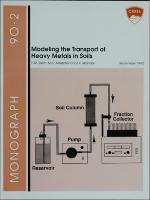Please use this identifier to cite or link to this item:
https://hdl.handle.net/11681/2666| Title: | Modeling the transport of heavy metals in soils |
| Authors: | Louisiana Agricultural Experiment Station Louisiana State University and Agricultural and Mechanical College Selim, Hussein Magd Eldin, 1944- Amacher, Michael C. Iskandar, I. K. (Iskandar Karam), 1938- |
| Keywords: | Convection-dispersion Heavy metals Kinetic retention Mobile/immobile water Multireaction models Sorption/desorption Soils metal content Soil leaching Mathematical models Computer programs Soils Soil pollution |
| Publisher: | Cold Regions Research and Engineering Laboratory (U.S.) Engineer Research and Development Center (U.S.) |
| Series/Report no.: | CRREL monograph ; 90-2. |
| Description: | CRREL Monograph Abstract: This monograph has two objectives. The first is to present an overview of the retention of heavy metals in soils and of methods of modeling their mobility in the soil profile. Widely used heavy-metal-retention models are described, with emphasis on the retention mechanisms characterized by time-dependent (or kinetic) and nonlinear-type reactions. Sorption properties based on quasi-equilibrium of the Freundlich-type retention for Co, Ni, Cu, Zn, Cd, Hg, V, Cr, Mo, B, Pb, P, As, S, and Se by a number of soil orders are given. The second objective is the development of four general-purpose models for describing the behavior of heavy metal retention and mobility in soils. The proposed models are referred to as MRM, MRTM, SOTS, and SOMIM. The classical convection-dispersion equation is invoked to describe the transport of dissolved chemicals present in the soil solution when steady water flow is encountered. The retention mechanisms considered for heavy metals include nonlinear kinetic mechanisms of the concurrent and concurrent-consecutive retention processes, a second-order kinetic approach, diffusion or first-order mass transfer of the mobile-immobile (two-region) concept, and irreversible reaction of the first-order kinetic type. Computer codes and sample input/output runs from each of these models are given, and validations of the models based on selected studies are presented. NOTE: This file is large. Allow your browser several minutes to download the file. |
| Rights: | Approved for public release; distribution is unlimited. |
| URI: | http://hdl.handle.net/11681/2666 |
| Appears in Collections: | Monograph |
Files in This Item:
| File | Description | Size | Format | |
|---|---|---|---|---|
| Monograph-90-2.pdf | 30.98 MB | Adobe PDF |  View/Open |